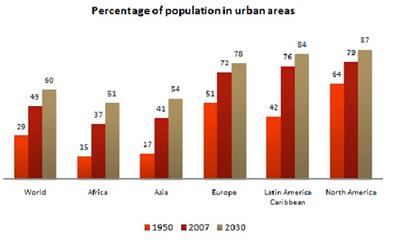IELTS Bar Chart - Proportion of City Populations
Hi,
I have been studying for the IELTS for over a year now, and my reading and listening is acceptable (estimated to be 8.0+), but my writing has been stagnating at 5.5. :(
Can anyone give me some suggestions?
Here is a task 1 essay by me:
The bar chart gives information about the percentage of the population living in urban areas in different parts of the world.
Summarise the information by selecting and reporting the main features, and make comparisons where relevant.
The bar chart illustrates the proportion of urban residents in six different areas of the world in 1950, 2007 as well as projections to 2050.
It can be seen that the proportion of the world's population living cities will have increased between 1950 and 2030. However, the change is more pronounced in regions than others.
For example, rapid urbanisation is expected in Africa and Asia, whose urban population is estimated to rise from just around 15% in 1950 to over 60% in 2050. The proportion of city dwellers in Ocenia, on the other hand, only saw a modest rise from 62% in 1930 to 71% in 2007, and is estimated to be just around 76% in 2050.
In Latin America and the Caribbean, only 42% of people were living in cities in 1970, a little less that the figure for Europe , which is at 51%. By 2007, however, the the latter had been surpassed by the former by around 4%, and this trend is expected to continue to 2050. Finally, North America is consistently the most urbanised region in the world from 1950 (64%) to 2050 (90%)
It took me a very very long time to finish this one, because I did not know how to structure the essay, you know what should i describe in the 2nd part, so on and so on. And I can't seem to think of any idea!! :(
Comments for IELTS Bar Chart - Proportion of City Populations
|
||
|
||
|
||
IELTS Bar Chart - Percentage of Population in Urban Areas
by Cher

The bar chart gives information about the percentage of the population living in urban areas in different parts of the world.
Summarise the information by selecting and reporting the main features, and make comparisons where relevant.
The bar chart shows the percentage of the population living in six different regions of the world in three different years.
In 1950, North America had 64 per cent of people living in the cities, reaching 90 per cent by 2050, makes it the highest percentage of population compared to other areas. By contrast, Africa had 15 per cent of citizens living in urban areas in 1950, which is the lowest percentage compared to the other regions of the world; however, it had the greatest change from 1950 to 2050, quadrupled from 15 per cent to 62 per cent. Moreover, Asia also had similar pattern of changes as Africa, increasing from 17 per cent in 1950 to 66 per cent in 2050. On contrary, Oceania has the least changes of percentage from 1950 to 2050; the difference is only 14 per cent. Moreover, the percentage of people who lived in Latin America and Caribbean has doubled from around 40 per cent to 80 per cent over a century.
In conclusion, it is clear that the percentage of population in urban areas in six parts of the world has increased over a hundred year. However, these percentages change at the different rates for each city.
Comments for IELTS Bar Chart - Percentage of Population in Urban Areas
|
||
|
||
Band 7+ eBooks
"I think these eBooks are FANTASTIC!!! I know that's not academic language, but it's the truth!"
Linda, from Italy, Scored Band 7.5












